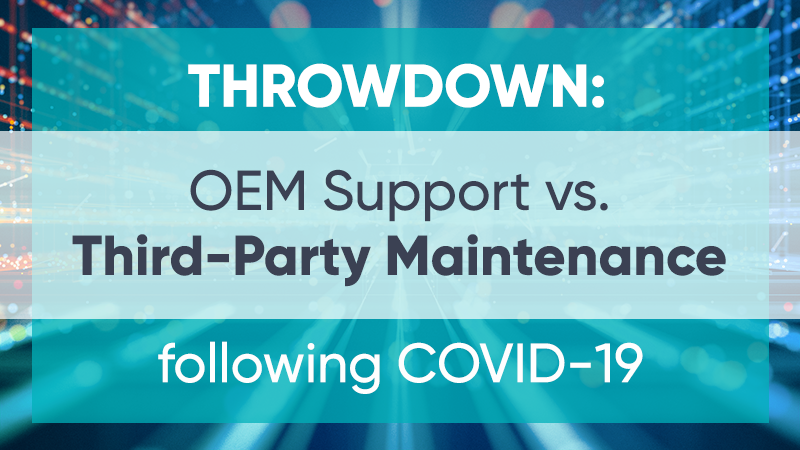Searching for savings following COVID-19.
IT leaders across the globe face enormous challenges responding to the COVID-19 pandemic. CIO magazine indicates that due to COVID-19, now 40% of IT budgets will remain flat and another 39% will decrease in 2020. Infrastructure and Operations teams face great pressure to deliver both cost savings initiatives and delivering fast-tracked initiatives to support the remote workforce.
Now is a great time to rationalize maintenance spending as one of 4 ways to drive coronavirus cost savings on tech according to David Borowski at Pace Harmon, where he recommended looking at support costs on hardware across computing and storage infrastructure and network equipment.
Is there an opportunity to save on hardware and support costs for infrastructure for servers, storage and network with an alternative to the OEM? Are there inherent risks associated with leaving maintenance to someone other than the OEM?
To dig deeper we decided a throwdown was warranted between original equipment manufacturers (OEM) support and third-party maintenance (TPM) to determine if this was an area of opportunity during the COVID-19 response.
What is OEM Maintenance?
When companies buy hardware products like servers, storage, and network from brands such as Cisco, HPE, and NetApp, the OEM typically provides an initial period of support and maintenance during a 1-3 year period after purchase during its warranty coverage. After the warranty expires, the OEMs offer post-warranty support options at an additional cost. Oftentimes, the equipment will be phased out with varying degrees of obsolescence including end of life and end of support life classifications intended to ensure upgrades to their newer equipment.
What is Third-Party Maintenance?
TPM is simply hardware support provided by someone other than the OEM and is referred to as an independent service provider or TPM provider. TPM providers can provide hardware support on servers, storage, and network equipment during and after hardware warranty periods.
Choosing between OEM Maintenance and Third-Party Maintenance following COVID-19.
Due to the pressures of getting cost savings quickly, cost reduction for the routine maintenance of servers, storage, and networks will be a major component of this review. Other factors we want to consider are hardware expertise, ability to extend the hardware lifecycle, coverage/response times for support, and flexibility provided to the company with the infrastructure to support.
What makes OEM Maintenance the best?
OEMs provide warranty service during an initial 1-3 year period after purchase and provide options to extend this support. They developed and manufactured the product and are viewed as the experts on the brand since they have deep engineering knowledge and provide necessary software updates and upgrades. The OEM will often phase out products and support in order to create obsolescence and encourage technology refresh.
What makes Third-Party Maintenance the best?
Third-party IT maintenance providers often can reduce maintenance costs dramatically for organizations by up to 60-70% while reducing your overall operating expenses. TPM reduces response times as they support many OEM brands (and are in many cases trained and certified across OEM products) eliminating shift of the blame between brands versus the root cause and focus on your uptime. Geographic coverage and access to parts are key for global businesses. TPM allows you to extend the lifecycle of your hardware beyond end-of-support life so you aren’t forced into an early refresh on hardware that meets your needs.
Determining the best fit for your business.
The five things we wanted to compare are summarized below and an advantage has been assigned.
-
Maintenance Costs
TPM will reduce your maintenance costs but the savings will vary based on your server, storage, or network equipment. Advantage TPM.
-
Hardware Expertise
OEMs have deep engineering expertise on their products and the firmware updates and patches. TPM providers also have extensive engineering facilities and their engineers are certified across multiple OEM products and can complete updates/upgrades/patches. For newly released and new families of hardware though, its Advantage OEM.
-
Hardware Lifecycle Extension
Extending the lifecycle of existing assets without impact to operations should be reviewed. Are there opportunities to postpone technology refreshes and avoid capital expenditures at this time? Can products be supported longer and have a plan for replacement parts without increased support costs? Advantage TPM.
-
Coverage and/or Response Times
TPM allows for the ability to mix and match service levels within a single location. The OEMs have standard service offers. Global coverage can be handled by TPMs while OEMs will often use outsourced help. OEM support will spend time ensuring it is their brand during an issue rather than solving the issue. This allows TPM to reduce the time from call to dispatch. Advantage TPM.
-
Flexibility
Do you have the ability to mix and match service levels? Do you want to manage many OEM contracts or just a single contract? Most OEMs each have a standard and you’ll have to manage to each. Advantage TPM.
Is OEM Maintenance or Third Party Maintenance Better?
The answer could be a hybrid model; however, at a time when organizations need to reduce maintenance costs – TPM is a great way to get substantial savings. If a company recently procured new hardware, then changing may not be in the best interest. However, if you have varying OEM support programs and see the need to simplify your support program and extend the lifecycle of your server, storage, or network infrastructure without impact to performance, then TPM is a great place to start.



